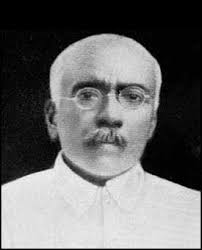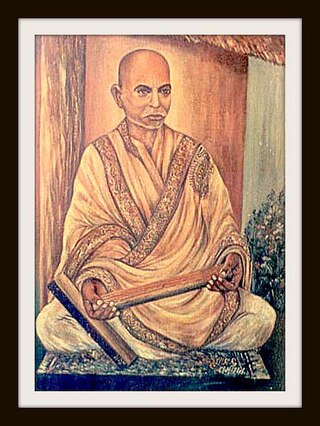Related Research Articles
Brahmagupta was an Indian mathematician and astronomer. He is the author of two early works on mathematics and astronomy: the Brāhmasphuṭasiddhānta, a theoretical treatise, and the Khaṇḍakhādyaka, a more practical text.

Bhāskara, also known as Bhāskarāchārya, and as Bhāskara II to avoid confusion with the 7th century mathematician Bhāskara I, was an Indian mathematician, astronomer and inventor. From verses in his main work, Siddhāṁta Śiromaṇī (सिद्धांतशिरोमणी), it can be inferred that he was born in 1114 in Vijjadavida (Vijjalavida) and living in the Satpuda mountain ranges of Western Ghats, believed to be the town of Patana in Chalisgaon, located in present-day Khandesh region of Maharashtra by scholars. In a temple in Maharashtra, an inscription supposedly created by his grandson Changadeva, lists Bhaskaracharya's ancestral lineage for several generations before him as well as two generations after him. Colebrooke who was the first European to translate (1817) Bhaskaracharya II's mathematical classics refers to the family as Maharashtrian Brahmins residing on the banks of the Godavari.
Vaṭeśvara, was a tenth-century Indian mathematician from Kashmir who presented several trigonometric identities. He was the author of the Vaṭeśvara-siddhānta, written in 904 AD, a treatise focusing on astronomy and applied mathematics.The work criticized Brahmagupta and defended Aryabhatta I. An edition of the first three chapters was published in 1962 by R. S. Sharma and Mukund Mishra. Al Biruni referred to the works by Vateswara, particularly the Karaṇasāra, noting that the author was the son of Mihdatta who belonged to Nagarapura. The Karaṇasāra uses 821 Saka era as a reference year.
Mahendra Sūri is the 14th century Jain astronomer who wrote the Yantraraja, the first Indian treatise on the astrolabe. He was trained by Madana Sūri, and was teacher to Malayendu Sūri. Jainism had a strong influence on mathematics particularly in the last couple of centuries BC. By the time of Mahendra Suri, however, Jainism had lost support as a national religion and was much less vigorous.
Kamalakara was an Indian astronomer and mathematician, came from a learned family of scholars from Golagrama, a village situated in Maharashtra State near Partha-puri (Pathari) on the northern bank of the river Godāvarī. His father was Nrsimha who was born in 1586. Two of Kamalakara's three brothers were also astronomer and mathematicians: Divakara, who was the eldest of the brothers born in 1606, and Ranganatha who was youngest. Kamalākara learnt astronomy from his elder brother Divākara, who compiled five works on astronomy. His family later moved to Vārāṇasī.

Līlāvatī is a treatise by Indian mathematician Bhāskara II on mathematics, written in 1150 AD. It is the first volume of his main work, the Siddhānta Shiromani, alongside the Bijaganita, the Grahaganita and the Golādhyāya.
Indian mathematics emerged in the Indian subcontinent from 1200 BCE until the end of the 18th century. In the classical period of Indian mathematics, important contributions were made by scholars like Aryabhata, Brahmagupta, Bhaskara II,Varāhamihira, and Madhava. The decimal number system in use today was first recorded in Indian mathematics. Indian mathematicians made early contributions to the study of the concept of zero as a number, negative numbers, arithmetic, and algebra. In addition, trigonometry was further advanced in India, and, in particular, the modern definitions of sine and cosine were developed there. These mathematical concepts were transmitted to the Middle East, China, and Europe and led to further developments that now form the foundations of many areas of mathematics.
The Brāhma-sphuṭa-siddhānta is a main work of Brahmagupta, written c. 628. This text of mathematical astronomy contains significant mathematical content, including the first good understanding of the role of zero, rules for manipulating both negative and positive numbers, a method for computing square roots, methods of solving linear and quadratic equations, and rules for summing series, Brahmagupta's identity, and Brahmagupta theorem.

Indian astronomy refers to astronomy practiced in the Indian subcontinent. It has a long history stretching from pre-historic to modern times. Some of the earliest roots of Indian astronomy can be dated to the period of Indus Valley civilisation or earlier. Astronomy later developed as a discipline of Vedanga, or one of the "auxiliary disciplines" associated with the study of the Vedas dating 1500 BCE or older. The oldest known text is the Vedanga Jyotisha, dated to 1400–1200 BCE.
In algebra, Brahmagupta's identity says that, for given , the product of two numbers of the form is itself a number of that form. In other words, the set of such numbers is closed under multiplication. Specifically:

Bapudeva Sastri or Narasimha Deva Paranjpe (1821–1900) was an Indian mathematician.
This is a timeline of pure and applied mathematics history. It is divided here into three stages, corresponding to stages in the development of mathematical notation: a "rhetorical" stage in which calculations are described purely by words, a "syncopated" stage in which quantities and common algebraic operations are beginning to be represented by symbolic abbreviations, and finally a "symbolic" stage, in which comprehensive notational systems for formulas are the norm.

Ganesh Prasad was an Indian mathematician who specialised in the theory of potentials, theory of functions of a real variable, Fourier series and the theory of surfaces. He was trained at the Universities of Cambridge and Göttingen and on return to India he helped develop the culture of mathematical research in India. The mathematical community of India considers Ganesh Prasad as the ′Father of Mathematical Research in India′. He was also an educator taking special interest in the advancement of primary education in the rural areas of India.
The Golden Age of Islam, which saw a flourishing of science, notably mathematics and astronomy, especially during the 9th and 10th centuries, had a notable Indian influence.
Bijaganita was treatise on algebra by the Indian mathematician Bhāskara II. It is the second volume of his main work Siddhānta Shiromani alongside Lilāvati, Grahaganita and Golādhyāya.

Siddhānta Śiromaṇi is the major treatise of Indian mathematician Bhāskara II. He wrote the Siddhānta Śiromaṇi in 1150 when he was 36 years old. The work is composed in Sanskrit Language in 1450 verses.

Pathani Samanta better known as Mahamahopadhyaya Chandrasekhara Singha Harichandana Mahapatra Samanta, was an Indian astronomer, mathematician and scholar who measured the distance from the Earth to the Sun with a bamboo pipe, and traditional instruments. He was born on 13 December 1835 in Purnimanta Pousha Krishna Ashtami, and died on 11 June 1904 in Purnimanta Adhika Jyeshtha Krishna Trayodashi.
Pancha-siddhantika is a 6th-century CE Sanskrit-language text written by astrologer-astronomer Varāhamihira in present-day Ujjain, India. It summarizes the contents of the treatises of the five contemporary schools of astronomy (siddhantas) prevalent in India.
References
- ↑ Joseph W. Dauben; Christoph J. Scriba (23 September 2002). Writing the History of Mathematics: Its Historical Development. Springer Science & Business Media. pp. 312–313. ISBN 978-3-7643-6167-9.
- ↑ Prasad, Ganesh. Some great mathematicians of the nineteenth century. Krishna Prakashan Media. p. xi.
- ↑ Patwardhan, K.S.; Naimpally, A.S.; Singh, Shyamlal (2001). Līlāvatī of Bhāskarācārya: a treatise of mathematics of Vedic tradition : with rationale in terms of modern mathematics largely based on N.H. Phadke's Marāthī translation of Līlāvatī. Motilal Banarsidass. p. xx. ISBN 978-81-208-1420-2 . Retrieved 27 September 2011.
- 1 2 3 4 Hoiberg, Dale (2000). Students' Britannica India:Select essays. India: Popular Prakashan. p. 333. ISBN 9780852297629.
- ↑ "Metric Measures, Volumes 7-8". 1964. University of California. 1964. p. 12. Retrieved 20 August 2010.